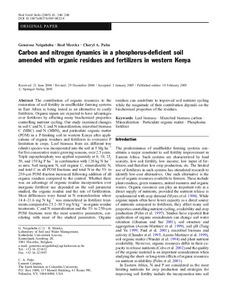| dc.contributor.author | Nziguheba, Generose |
| dc.contributor.author | Merckx, R. |
| dc.contributor.author | Palm, C. |
| dc.date.accessioned | 2019-12-04T11:18:54Z |
| dc.date.available | 2019-12-04T11:18:54Z |
| dc.date.issued | 2005 |
| dc.identifier.citation | Nziguheba, G., Merckx, R. & Palm, C. (2005). Carbon and nitrogen dynamics in a phosphorus-deficient soil amended with organic residues and fertilizers in western Kenya. Biology and Fertility of Soils, 41(4), 240-248. |
| dc.identifier.issn | 0178-2762 |
| dc.identifier.uri | https://hdl.handle.net/20.500.12478/3350 |
| dc.description.abstract | The contribution of organic resources to the restoration of soil fertility in smallholder farming systems in East Africa is being tested as an alternative to costly fertilizers. Organic inputs are expected to have advantages over fertilizers by affecting many biochemical properties controlling nutrient cycling. Our study examined changes in soil C and N, C and N mineralization, microbial biomass C (MBC) and N (MBN), and particulate organic matter (POM) in a P-limiting soil in western Kenya after applications of organic residues and fertilizers to overcome P limitation to crops. Leaf biomass from six different tree (shrub) species was incorporated into the soil at 5 Mg ha−1 for five consecutive maize growing seasons, over 2.5 years. Triple superphosphate was applied separately at 0, 10, 25, 50, and 150 kg P ha−1 in combination with 120 kg N ha−1 as urea. Soil inorganic N, soil organic C, mineralizable N, and total C in all POM fractions and total N in the 53- to 250-μm POM fraction increased following addition of all organic residues compared to the control. Whether there was an advantage of organic residue incorporation over inorganic fertilizer use depended on the soil parameter studied, the organic residue and the rate of fertilization. Most differences were found in N mineralization where 14.4–21.6 mg N kg−1 was mineralized in fertilizer treatments compared to 25.2–30.5 mg N kg−1 in organic residue treatments. C and N mineralization and the 53- to 250-μm POM fractions were the most sensitive parameters, correlating with most of the studied parameters. Organic residues can contribute to improved soil nutrient cycling while the magnitude of their contribution depends on the biochemical properties of the residues. |
| dc.description.sponsorship | International Development Research Centre |
| dc.language.iso | en |
| dc.subject | Leaf Biomass |
| dc.subject | Microbial Biomass Carbon |
| dc.subject | Mineralization |
| dc.subject | Particulate Organic Matter |
| dc.subject | Phosphorus Fertilizer |
| dc.title | Carbon and nitrogen dynamics in a phosphorus deficient soil amended with organic residues and fertilizers in western Kenya |
| dc.type | Journal Article |
| dc.description.version | Peer Review |
| cg.contributor.affiliation | Katholieke Universiteit Leuven |
| cg.contributor.affiliation | International Institute of Tropical Agriculture |
| cg.contributor.affiliation | Columbia University |
| cg.coverage.region | Acp |
| cg.coverage.region | Africa |
| cg.coverage.region | Europe |
| cg.coverage.region | East Africa |
| cg.coverage.region | North America |
| cg.coverage.country | Belgium |
| cg.coverage.country | Kenya |
| cg.coverage.country | United States |
| cg.authorship.types | CGIAR and advanced research institute |
| cg.iitasubject | Soil Health |
| cg.iitasubject | Soil Fertility |
| cg.iitasubject | Disease Control |
| cg.iitasubject | Soil Information |
| cg.iitasubject | Plant Diseases |
| cg.iitasubject | Plant Breeding |
| cg.iitasubject | Pests Of Plants |
| cg.iitasubject | Farm Management |
| cg.iitasubject | Farming Systems |
| cg.iitasubject | Plant Production |
| cg.iitasubject | Integrated Soil Fertility Management |
| cg.accessibilitystatus | Limited Access |
| local.dspaceid | 95024 |

